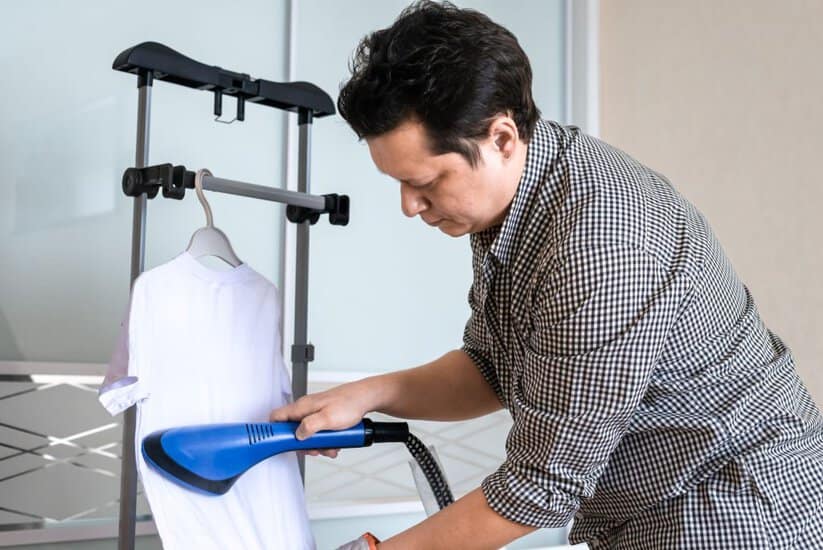When shopping for a dress shirt, one critical aspect to consider is the fit of the collar since it plays a significant role in overall comfort and style. It’s essential to find a balance, ensuring that the collar is neither too tight, which can cause discomfort and difficulty in moving or swallowing, nor too loose, which can look sloppy and detract from a sharp appearance.
Properly fitted collars should leave just enough space to slide in two fingers between your neck and the collar, a guideline often referred to as the “two-finger rule.”

Selecting the right size collar is the first step towards achieving a comfortable fit, but various adjustments and tailoring options are also available for a more custom fit. The material of the shirt and the style of the collar are other factors to be taken into account.
They influence not only the comfort but also the collar’s functionality and compatibility with ties and other accessories. Moreover, the fit of the collar can affect your posture and movement, hence, understanding the impact of a well-fitting collar becomes an integral part of dressing well.
Key Takeaways on How Tight Should a Man’s Dress Shirt Collar Be?
- A well-fitted collar is crucial for comfort and style in men’s dress shirts.
- The “two-finger rule” can guide proper collar fit without compromising comfort or appearance.
- Material, style, and tailoring adjustments are important for achieving an ideal collar fit.
Also don’t miss:
- Are My Dress Shirt Sleeves Too Long?
- Which Shirts Should Be Tucked In?
- How Do You Button a Dress Shirt?
Understanding Dress Shirt Collar Fit
Choosing the right collar fit is crucial for comfort and style. Here, I’ll explain how to measure for the correct tightness and what this means across different collar types.
The Two-Finger Rule
The Two-Finger Rule is a reliable method to ensure a dress shirt collar fits properly. When the collar is fully buttoned, I should be able to fit two fingers, no more, no less, between my neck and the collar.
This ensures that the collar is snug enough to look sharp while providing enough room for comfort and movement. Following this rule helps prevent a collar from being too tight, which can cause discomfort, or too loose, which can appear unkempt.
Collar Types and Fit
Dress shirt collars come in various shapes and sizes, each with a unique fit.
- Point Collar: The most common type, it suits most tie knot sizes. It should sit comfortably around my neck without pressing into the skin.
- Spread Collar: This collar displays more of the upper shirt and is ideal for larger tie knots. Proper fit means that it complements the proportions of my face without being restrictive.
- Button-Down Collar: A casual style where the collar points are fastened down by buttons. The Two-Finger Rule still applies to ensure the fit is neither too tight nor too loose.
- Cutaway Collar: With a wide spread, this collar allows for a bolder tie knot. Despite its shape, the collar should still follow the Two-Finger Rule.
- Wing Collar: Typically worn with a bow tie and tuxedo, the collar’s points sit flat, resembling wings. It should hug my neck without constricting.
- Club Collar: With its rounded edges, this vintage style should still leave enough space for comfort around my neck while maintaining a tidy appearance.
For each type, the fit is essential, as it ensures that the collar looks good and feels comfortable, especially when wearing a tie. A well-fitted collar complements the overall appearance of a dress shirt.
Selecting the Right Size for Comfort and Style

When it comes to dress shirts, I understand the balance between a snug fit and all-day comfort is crucial. Selecting the right collar size is essential to look sharp and feel at ease.
Measuring Your Neck
To measure my neck, I use a cloth measuring tape and wrap it around my neck, just below the Adam’s apple. I ensure it’s snug but not tight, leaving enough room to slip in one finger between my neck and the tape.
This measurement is my true neck size. If the number lands on a half size, it’s best to round up to the next whole size to provide a balance of comfort without being too tight.
Identifying the Correct Shirt Size
After measuring, I cross-reference my neck measurement with a brand’s sizing chart to find my ideal shirt size. The right shirt should fit comfortably around my neck without any gaps when the top button is fastened.
I also make sure there’s no bunching or pulling at the body or buttons, which indicates a good fit around the chest and waist. This ensures my dress shirt looks tailored and feels comfortable throughout the day.
Balancing Comfort and Appearance
The ideal shirt collar fit strikes a balance where it feels comfortable and enhances my overall appearance. Whether I choose to wear a tie or go without one, the collar should sit properly against my neck without causing discomfort or looking unkempt.
The Role of a Tie
When I wear a tie, I ensure the collar appears neat and symmetrical. The tie knot needs to fill the space provided by the collar without bulging or constricting. Following the two-finger rule, I make sure I can place two fingers between my neck and the collar for a measurement that promises both comfort and a sharp look.
Collar Options for Different Occasions
For different occasions, I choose collar styles that suit the level of formality required. A cutaway or spread collar allows for a larger tie knot and often suits business environments.
In contrast, a button-down collar offers a more casual appearance and can be worn comfortably without a tie. The key is to select a collar that complements my attire and the setting, ensuring I present myself well without sacrificing comfort.
Adjustment and Tailoring Options

In my experience, achieving the perfect collar fit is crucial for both comfort and style. I’ll discuss when it’s appropriate to seek professional alterations and how to make minor adjustments at home.
When to Visit a Tailor
I recommend visiting a tailor when the collar of a dress shirt does not fit correctly. A tailor can assess the collar band size and make the necessary alterations. It is important to note that altering the size of a shirt collar is a complex process because it requires adjusting the collar band—a task that can impact the fit of the entire shirt.
Making Minor Adjustments at Home
If I notice minor issues with my dress shirt collar, I can sometimes make adjustments myself. For example, using collar extenders can provide a small amount of additional room if the collar is just slightly too tight. However, for a permanent fix or in cases where the collar is significantly too loose or too tight, a professional adjustment is advisable.
Material and Style Considerations
When selecting a dress shirt, I consider the collar’s material and style as they heavily influence both appearance and comfort. These elements also impact a shirt’s adaptability across different settings and its integration into my existing wardrobe.
Choosing Fabrics and Patterns
The fabric of a dress shirt plays a crucial role in how the collar will sit on my neck. I look for materials that provide a balance between structure and flexibility. Cotton is a perennial favorite for its breathability and ability to maintain a sharp collar line. When it comes to patterns,
I choose based on the occasion. For instance, solid colors and subtle patterns offer a versatile look that pairs well with various menswear pieces from my wardrobe.
- Breathable Fabrics: Opt for 100% cotton or linen for a comfortable fit.
- Stretch: A small percentage of elastane can ensure the collar moves with me.
Collar Styles and Wardrobe Versatility
The style of the collar affects not just its tightness but also how the dress shirt complements different outfits. A button-down collar is my go-to for casual settings, while I reserve spread collars for formal occasions. This style selection enhances my personal style and ensures my dress shirts work in various social settings, making them highly versatile components of menswear.
- Formal Attire: Pair a cutaway or spread collar with a business suit.
- Casual Ensemble: A button-down collar fits well with chinos and a blazer.
Each collar style I choose serves a purpose and fits comfortably without restriction or excess slack. The tightness is perfect when I can comfortably fit a couple of fingers inside the buttoned collar—a practical insight I’ve adopted that ensures my shirts are neither too tight nor too loose.
Caring for Your Dress Shirt Collar

Ensuring the dress shirt collar looks impeccable starts with proper washing and ironing techniques. Additionally, maintaining the shape and structure of the collar is crucial for a sharp appearance.
Washing and Ironing Tips
When I wash my dress shirts, I always check the care label for specific instructions to prevent any damage. It’s important to remove the collar stays before washing, as this prevents them from bending and keeps the collar’s form intact. I prefer to wash dress shirts in cold water and on a gentle cycle to minimize wear on the fabric.
For ironing, I start with the collar, which should be ironed flat from the points inward to avoid creasing. I make sure the iron is set to the correct temperature and use a pressing cloth to protect the fabric from direct heat. This helps maintain the dress shirt features like its crisp appearance without risking heat damage.
Maintaining Collar Shape and Structure
To keep my dress shirt collar looking sharp, I use collar stays to ensure the points remain straight and do not curl. After ironing, I insert collar stays back into the slots under the collar; these can be made of metal or plastic, depending on personal preference. I find that metal stays usually offer better weight and rigidity.
Additionally, I hang my dress shirts on wide hangers to prevent the collar from sagging or losing its shape. In between wears, I store my shirts with the top button fastened, as this helps the collar maintain its structure.
Understanding the Impact of Fit on Posture and Movement
The fit of a dress shirt collar is not just a matter of appearance; I understand it also has significant implications for posture and freedom of movement. A well-fitted collar offers both a polished look and functional benefits.
Posture and Comfort
When it comes to posture, an overly tight collar constrains the neck, potentially encouraging a forward-head posture as I instinctively try to escape the tightness.
Conversely, a collar that’s too loose doesn’t provide the gentle structure that can actually remind me to keep my head held high. My aim is to ensure the collar sits snugly yet comfortably around my neck, allowing a finger’s width of space.
- Ideal collar fit: Enough space to insert one finger between my neck and the collar.
Range of Motion and Activity Tolerance
Now consider sleeves and armholes; their dimensions are crucial as they impact my overall range of motion. If I were to choose a sleeve length that is too short, I would find it pulls at the cuff during movement, which is both uncomfortable and restricting.
Conversely, overly long sleeves might catch or interfere with my tasks. Too-tight armholes cut into my underarms, limiting upper body movements and possibly altering my natural posture. I aim for sleeves and armholes that allow me full range of motion without fabric pull or excess material.
- Checklist for optimal sleeve and armhole fit:
- Sleeves allow wrist exposure for a watch or cufflinks.
- Armholes permit unimpeded arm raising and crossing.
Accessorizing with Collar-Complementary Pieces
When dressing to impress, I know that the accessories I choose can make or break my outfit. Ensuring that ties, cufflinks, watches, and jewelry complement the dress shirt collar is essential for a polished look.
Choosing Suitable Ties and Cufflinks
Tie Selection:
- Pattern and Color: I always select a tie that harmonizes with the color of my shirt. For a crisp white shirt, the range of tie options is vast, allowing for bold patterns or striking colors.
- Knot and Collar Compatibility: I choose my tie knot based on the type of collar I have. For instance, a wider Windsor knot suits spread collars, while a slimmer Four-in-Hand knot is ideal for narrow, point collars.
- Sleeve Cuff Fit: Cufflinks are a small but mighty accessory. I ensure my shirt has French cuffs or convertible barrel cuffs to accommodate them.
- Design and Occasion: For formal events, I opt for cufflinks that are sleek and understated. In a business-casual setting, I might choose something with a little more personality, yet still keeping it professional.
Harmonizing With Watches and Jewelry

Watch Considerations:
- I match my watch to the formality of the occasion and ensure its band complements the tones of my dress shirt and other accessories.
- The watch should sit comfortably beneath the cuff; I check that my sleeve cuff fit allows the watch face to peek out elegantly when I bend my wrist.
Jewelry Coordination:
- With jewelry, less is usually more. A simple wedding band or a tasteful signet ring adds a touch of class without overshadowing my ensemble.
- I avoid over-accessorizing; if my cufflinks make a statement, I might forego a lapel pin or a bracelet to maintain a balanced look.
Frequently Asked Questions
When it comes to finding the perfect dress shirt, understanding collar fit is critical. It’s a balance of comfort and style—a collar that’s too tight or too loose can throw off your entire look.
What is the ideal fit for a dress shirt collar around the neck?
The ideal fit allows for two fingers to comfortably slide between your collar and neck without restricting movement. This ensures the collar is snug but not constrictive.
How can you tell if a dress shirt collar is too tight or too loose?
A too-tight collar makes swallowing or turning the head uncomfortable, while a too-loose collar looks sloppy and can ride up the back of the neck. Proper Cloth mentions that you should measure post-wash dimensions for accuracy, as fabric type affects shrinkage.
Can collar extenders be a solution for dress shirt collars that are too snug?
Collar extenders can offer a temporary fix for a collar that’s a bit too snug. They should not, however, be relied on for long-term use, as they may impair the shirt’s overall fit and style.
What are the indications that you need to size up or down your dress shirt collar?
An indication that you need to size up is difficulty buttoning the collar or visible strain around the neck. Conversely, if the collar hangs too loosely and creates gaps even when fully buttoned, it’s time to size down.
How should a tie fit in relation to the shirt collar, and what implications does collar tightness have on this fit?
A tie should sit comfortably under the shirt collar with just enough tension to look sharp but not distort the collar’s shape. Collar tightness directly affects this as a tight collar can make the tie overly constricted, while a loose collar won’t support the tie properly.
What adjustments can be made if a dress shirt collar is too large?
Tailoring is often the best solution for a collar that is too large, as it allows for a customized fit. Other adjustments are also possible, such as using collar stays or moving the button, but these are minor and might not solve significant sizing issues.

Samoel Ovanessian is the founder and creator of StylishAlpha.com – a website dedicated to men’s fashion. As a proud owner of more than 200 ties, he loves digging through new clothing combinations for everyday use, formal events and even just for fun. You can read more about Samoel here.

